Mechanical and Hygrothermal Properties of Zeolite-Modified Pervious Concrete in Hot and Humid Area
Abstract
:1. Introduction
2. Materials and Methods
2.1. Materials and Mix Design
2.2. Experimental Methods
3. Results and Discussion
3.1. Density, Porosity and Permeability
3.2. Compressive and Splitting Tensile Strength
3.2.1. Compressive Strength
3.2.2. Splitting Tensile Strength
3.3. Water Absorption Properties
3.4. Evaporative Cooling Properties
3.4.1. Evaporation Profile
3.4.2. Surface Temperature
4. Conclusions
Author Contributions
Funding
Conflicts of Interest
References
- Qin, Y. A review on the development of cool pavements to mitigate urban heat island effect. Renew. Sustain. Energy Rev. 2015, 52, 445–459. [Google Scholar] [CrossRef]
- Tan, K.; Qin, Y.; Du, T.; Li, L.; Zhang, L.; Wang, J. Biochar from waste biomass as hygroscopic filler for pervious concrete to improve evaporative cooling performance. Constr. Build. Mater. 2021, 287, 123078. [Google Scholar] [CrossRef]
- Tan, K.; Qin, Y.; Wang, J. Evaluation of the properties and carbon sequestration potential of biochar-modified pervious concrete. Constr. Build. Mater. 2022, 314, 125648. [Google Scholar] [CrossRef]
- Pacheco-Torgal, F.; Labrincha, J.A.; Cabeza, L.F.; Granqvist, C.G. Eco-Efficient Materials for Mitigating Building Cooling Needs; Woodhead Publishing: Sawston, UK, 2015. [Google Scholar]
- Santamouris, M.; Synnefa, A.; Karlessi, T. Using advanced cool materials in the urban built environment to mitigate heat islands and improve thermal comfort conditions. Sol. Energy 2011, 85, 3085–3102. [Google Scholar] [CrossRef]
- Qin, Y.; Liang, J.; Yang, H.; Deng, Z. Gas permeability of pervious concrete and its implications on the application of pervious pavements. Measurement 2016, 78, 104–110. [Google Scholar] [CrossRef]
- Li, H.; Harvey, J.; Ge, Z. Experimental investigation on evaporation rate for enhancing evaporative cooling effect of permeable pavement materials. Constr. Build. Mater. 2014, 65, 367–375. [Google Scholar] [CrossRef]
- Wang, J.; Meng, Q.; Zou, Y.; Qi, Q.; Tan, K.; Santamouris, M.; He, B.-J. Performance synergism of pervious pavement on stormwater management and urban heat island mitigation: A review of its benefits, key parameters, and co-benefits approach. Water Res. 2022, 221, 118755. [Google Scholar] [CrossRef]
- Zhang, L.; Liu, X.; Meng, Q.; Zhang, Y. Experimental study on the impact of mass moisture content on the evaporative cooling effect of porous face brick. Energy Effic. 2016, 9, 511–523. [Google Scholar] [CrossRef]
- Qin, Y.; He, Y.; Hiller, J.; Mei, G. A new water-retaining paver block for reducing runoff and cooling pavement. J. Clean. Prod. 2018, 199, 948–956. [Google Scholar] [CrossRef]
- Yamagata, H.; Nasu, M.; Yoshizawa, M.; Miyamoto, A.; Minamiyama, M. Heat island mitigation using water retentive pavement sprinkled with reclaimed wastewater. Water Sci. Technol. A J. Int. Assoc. Water Pollut. Res. 2008, 57, 763. [Google Scholar] [CrossRef]
- Tan, K.; Wang, J. Substrate modified with biochar improves the hydrothermal properties of green roofs. Environ. Res. 2023, 216, 114405. [Google Scholar] [CrossRef] [PubMed]
- Okada, K.; Ooyama, A.; Isobe, T.; Kameshima, Y.; Nakajima, A.; Mackenzie, K.J.D. Water Retention Properties of Porous Geopolymers for Use in Cooling Applications. J. Eur. Ceram. Soc. 2009, 29, 1917–1923. [Google Scholar] [CrossRef]
- Ozel, B.F.; Sakallı, Ş.; Şahin, Y. The effects of aggregate and fiber characteristics on the properties of pervious concrete. Constr. and Build. Mater. 2022, 356, 129294. [Google Scholar] [CrossRef]
- Nakayama, T.; Fujita, T. Cooling effect of water-holding pavements made of new materials on water and heat budgets in urban areas. Landsc. Urban Plan. 2010, 96, 57–67. [Google Scholar] [CrossRef]
- Samimi, K.; Kamali-Bernard, S.; Maghsoudi, A.A. Durability of self-compacting concrete containing pumice and zeolite against acid attack, carbonation and marine environment. Constr. Build. Mater. 2018, 165, 247–263. [Google Scholar] [CrossRef]
- Ramezanianpour, A.A.; Mousavi, R.; Kalhori, M.; Sobhani, J.; Najimi, M. Micro and macro level properties of natural zeolite contained concretes. Constr. Build. Mater. 2015, 101, 347–358. [Google Scholar] [CrossRef]
- Tran, Y.T.; Lee, J.; Kumar, P.; Kim, K.-H.; Lee, S.S. Natural zeolite and its application in concrete composite production. Compos. Part B: Eng. 2019, 165, 354–364. [Google Scholar] [CrossRef]
- Najimi, M.; Sobhani, J.; Ahmadi, B.; Shekarchi, M. An experimental study on durability properties of concrete containing zeolite as a highly reactive natural pozzolan. Constr. Build. Mater. 2012, 35, 1023–1033. [Google Scholar] [CrossRef]
- Nas, M.; Kurbetci, S. Mechanical, durability and microstructure properties of concrete containing natural zeolite. Comput. Concr 2018, 22, 449–459. [Google Scholar]
- Trung, N.T.; Alemi, N.; Haido, J.H.; Shariati, M.; Baradaran, S.; Yousif, S.T. Reduction of cement consumption by producing smart green concretes with natural zeolites. Smart Struct. Syst 2019, 24, 415–425. [Google Scholar]
- Zhou, B.; Shi, J.; Chen, Z.Q. Experimental study on moisture migration process of zeolite-based composite humidity control material. Appl. Therm. Eng. 2018, 128, 604–613. [Google Scholar] [CrossRef]
- Tan, K.; Pang, X.; Qin, Y.; Wang, J. Properties of cement mortar containing pulverized biochar pyrolyzed at different temperatures. Constr. Build. Mater. 2020, 263, 120616. [Google Scholar] [CrossRef]
- CJJ/T 135; TechnicalSpecification for Pervious Cement Concrete Pavement. Ministry of Housing and Urban-Ural Construction of the People’s Republic of China: Beijing, China, 2009. (In Chinese)
- ASTM C1699-09; Standard Test Method for Moisture Retention Curves of Porous Building Materials Using Pressure Plates. ASTM International: West Conshohocken, PA, USA, 2009.
- ASTM C1701/C1701M-17a; Standard Test Method for Infiltration Rate of In Place Pervious Concrete. ASTM International: West Conshohocken, PA, USA, 2017.
- ASTM. ASTM C1585e13; Standard Test Method for Measurement of rate of Absorption of Water by Hydraulic-Cement Concretes. ASTM International: West Conshohocken, PA, USA, 2013.
- ASTM. ASTM C39/C39M-14; Standard Test Method for Compressive Strength of Cylindrical Concrete Specimens. ASTM International: West Conshohocken, PA, USA, 2014.
- ASTM C496/C496M; Standard Test Method for Splitting Tensile Strength of Cylindrical Concrete Specimens. ASTM International: West Conshohocken, PA, USA, 2011.
- Qin, Y.; Pang, X.; Tan, K.; Bao, T. Evaluation of pervious concrete performance with pulverized biochar as cement replacement. Cem. Concr. Compos. 2021, 119, 104022. [Google Scholar] [CrossRef]
- Dixit, A.; Gupta, S.; Pang, S.D.; Kua, H.W. Waste Valorisation using biochar for cement replacement and internal curing in ultra-high performance concrete. J. Clean. Prod. 2019, 238, 117876. [Google Scholar] [CrossRef]

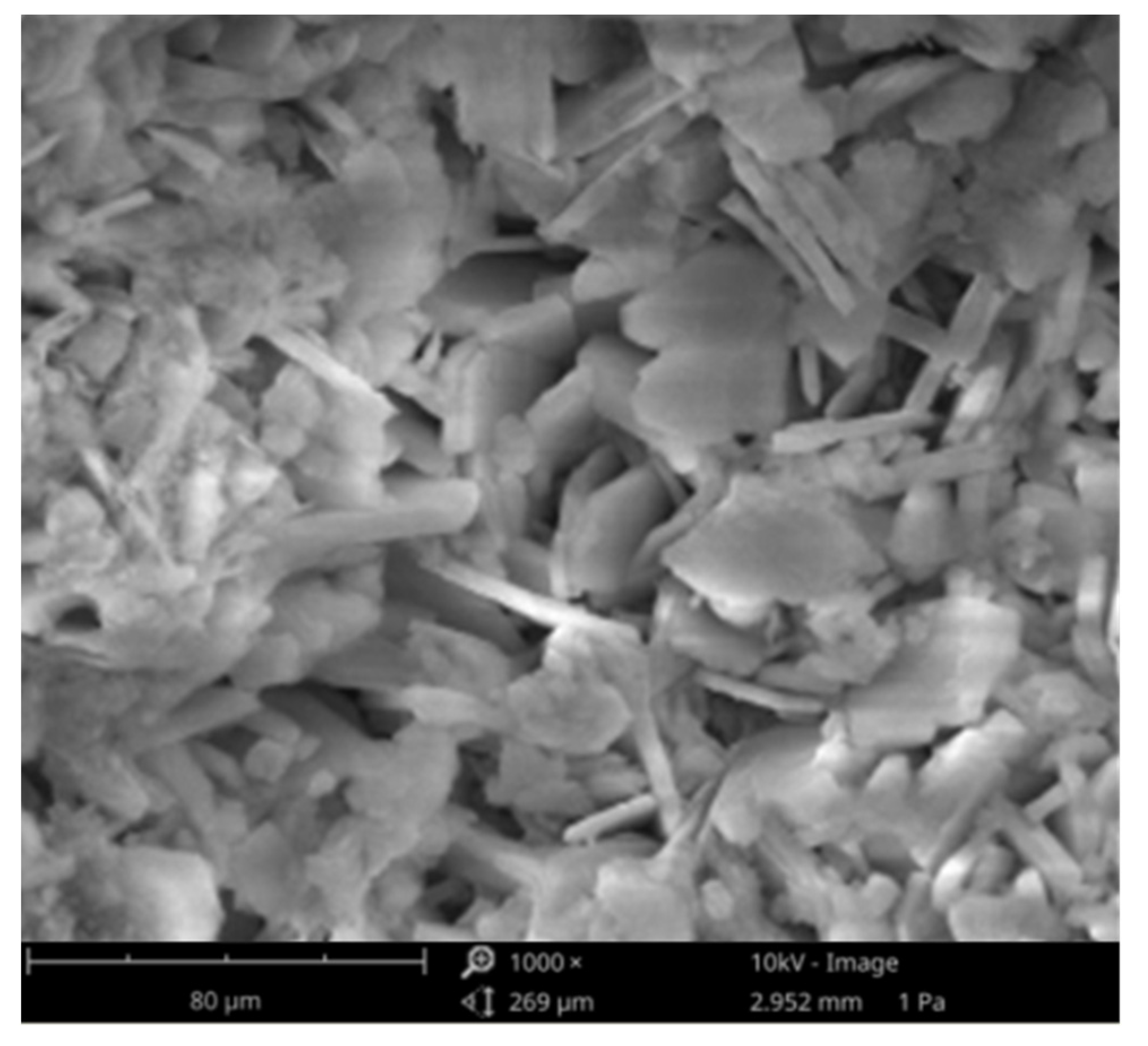
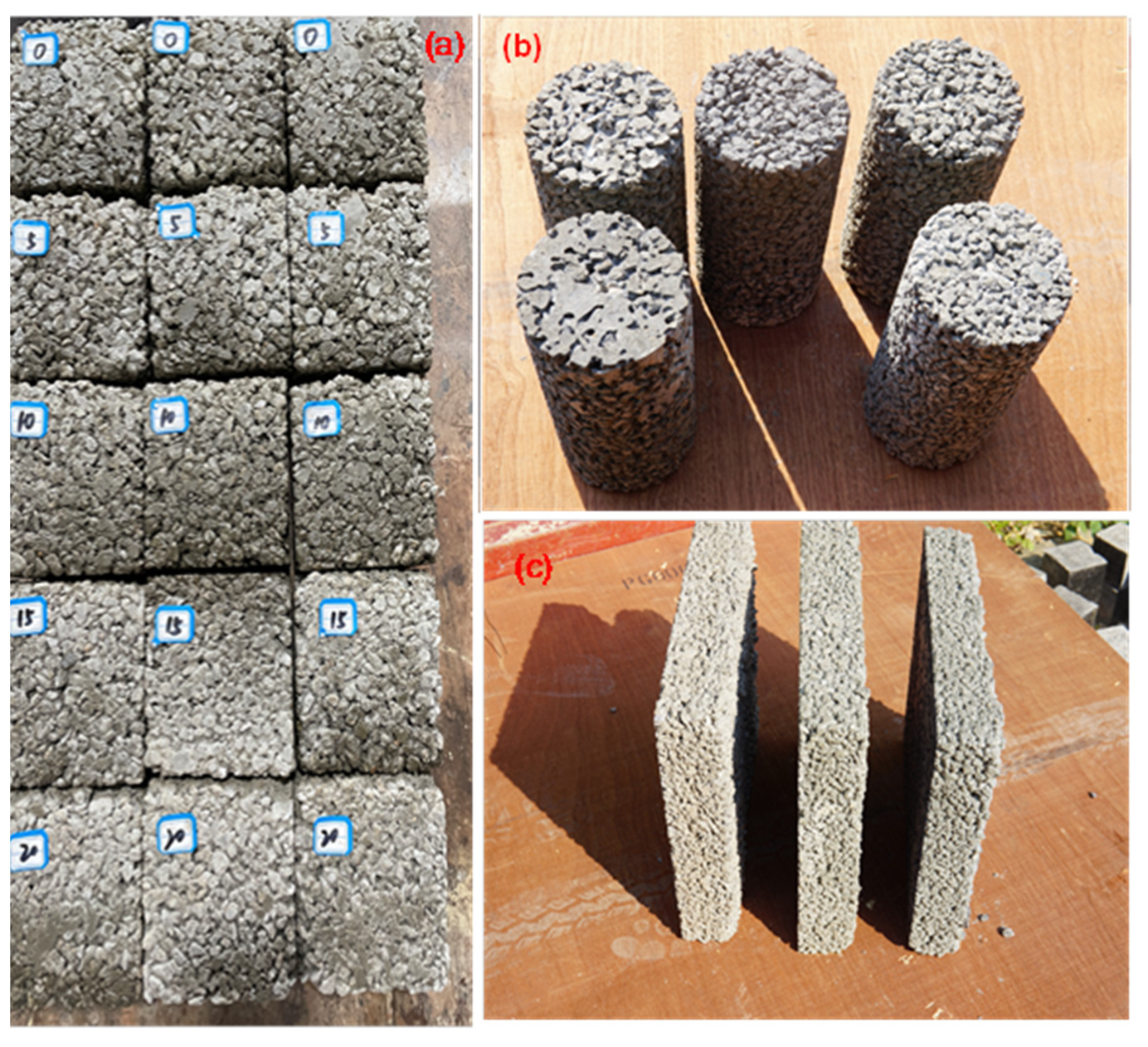
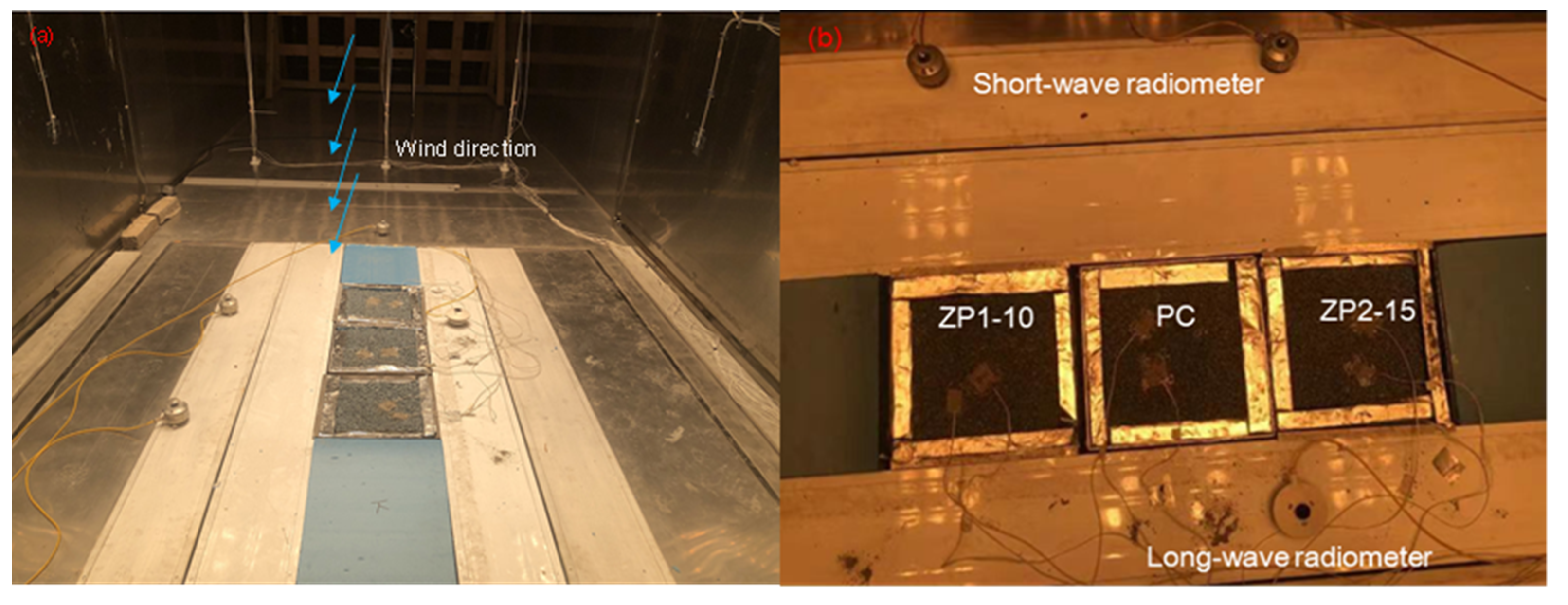

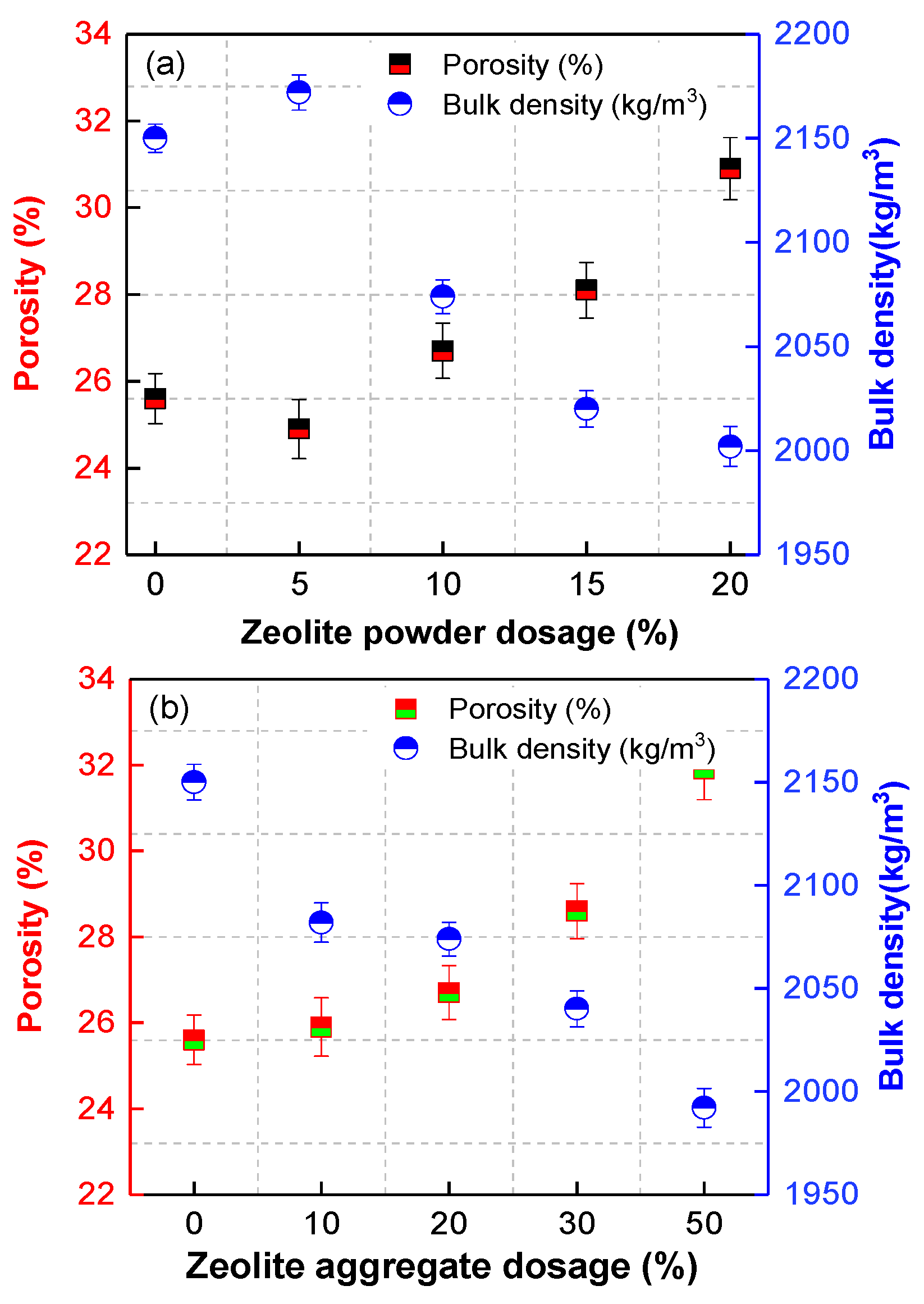


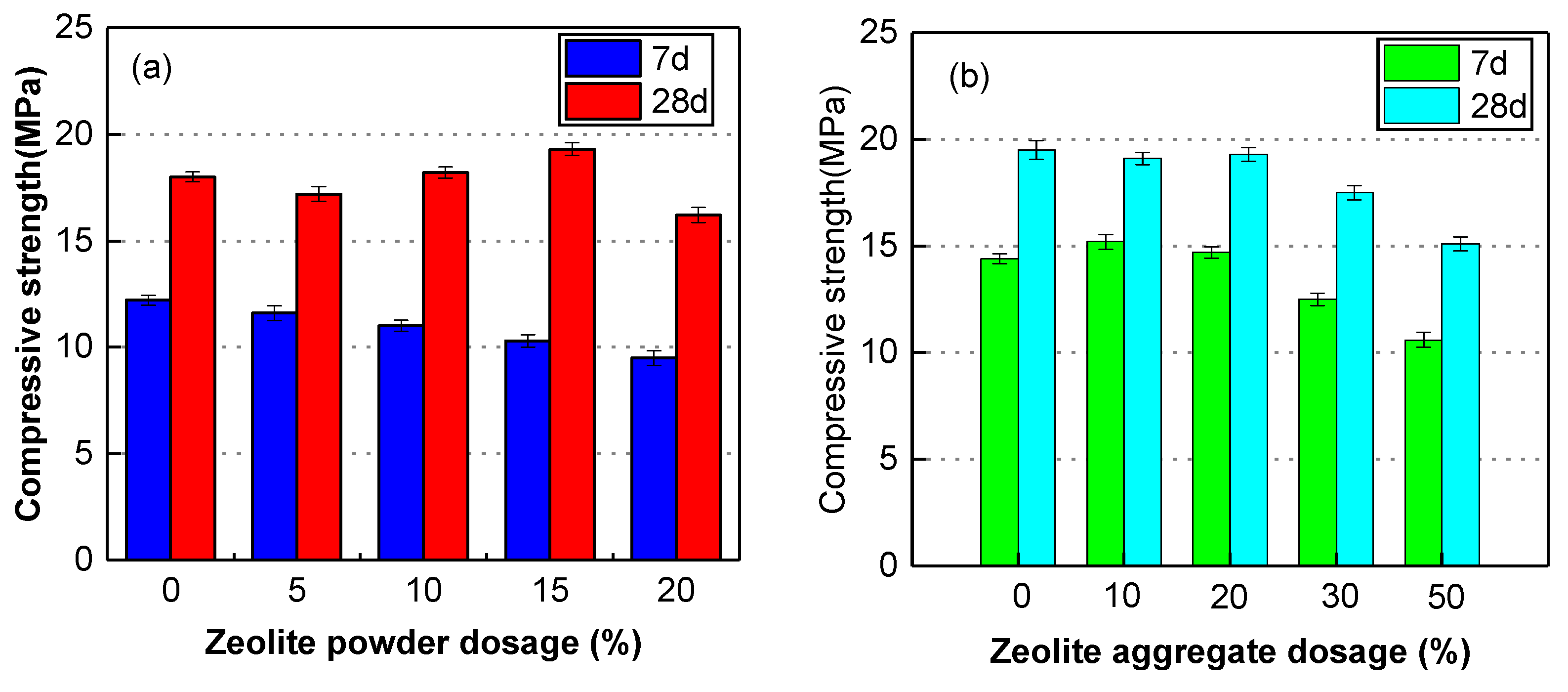
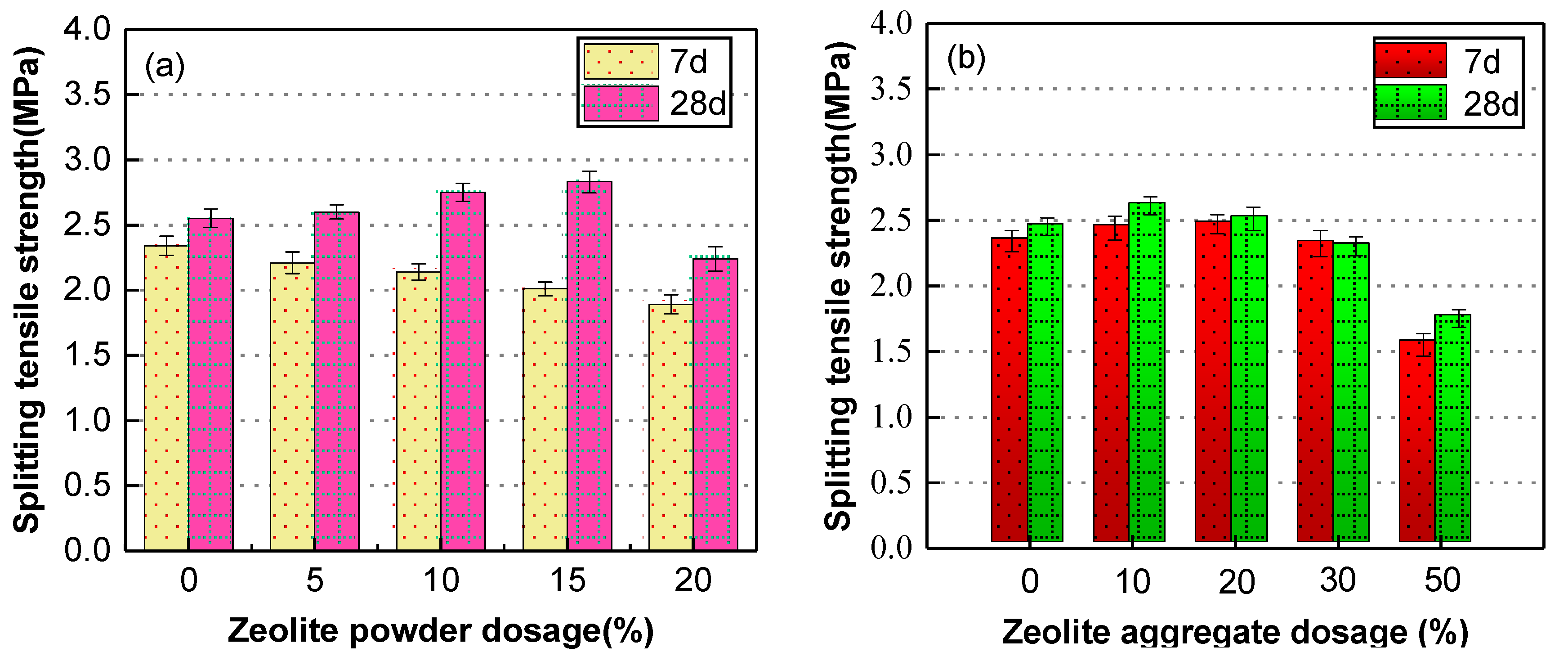
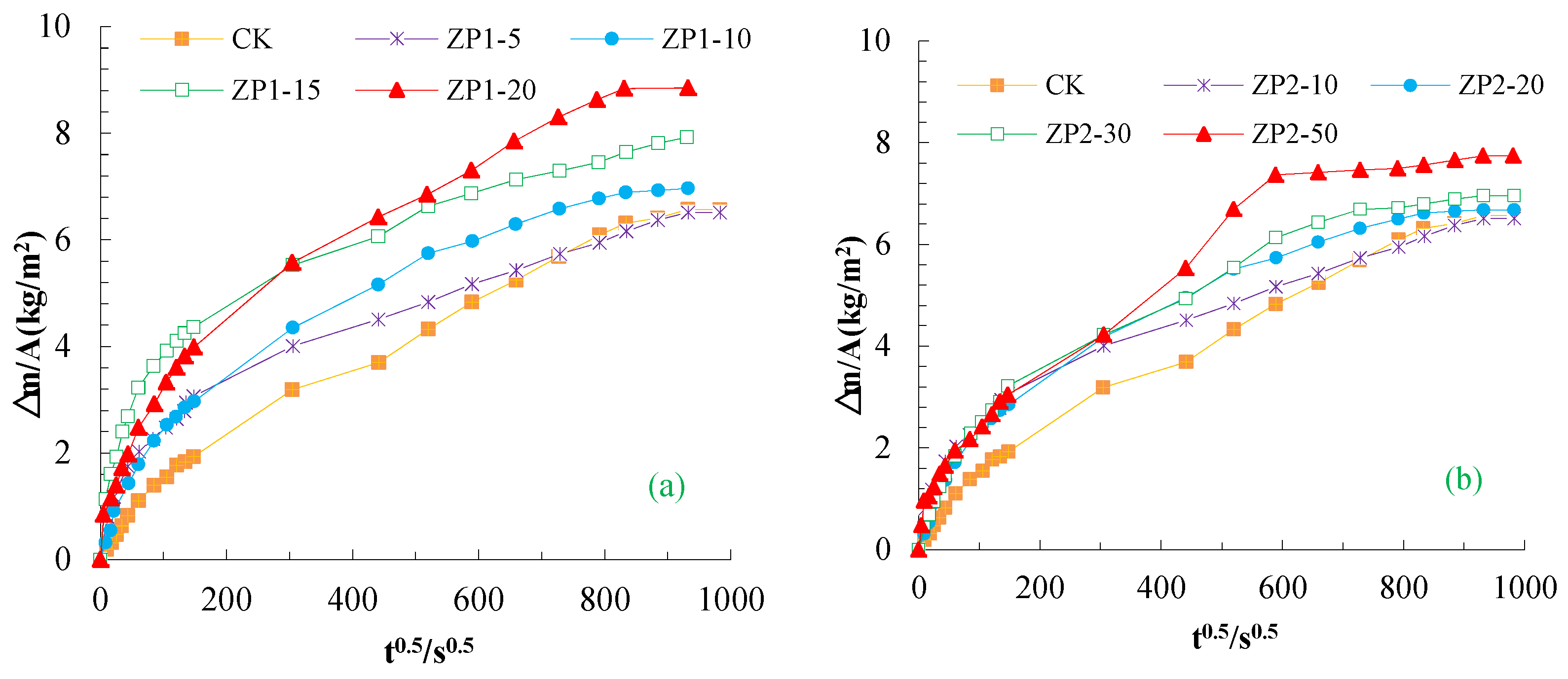
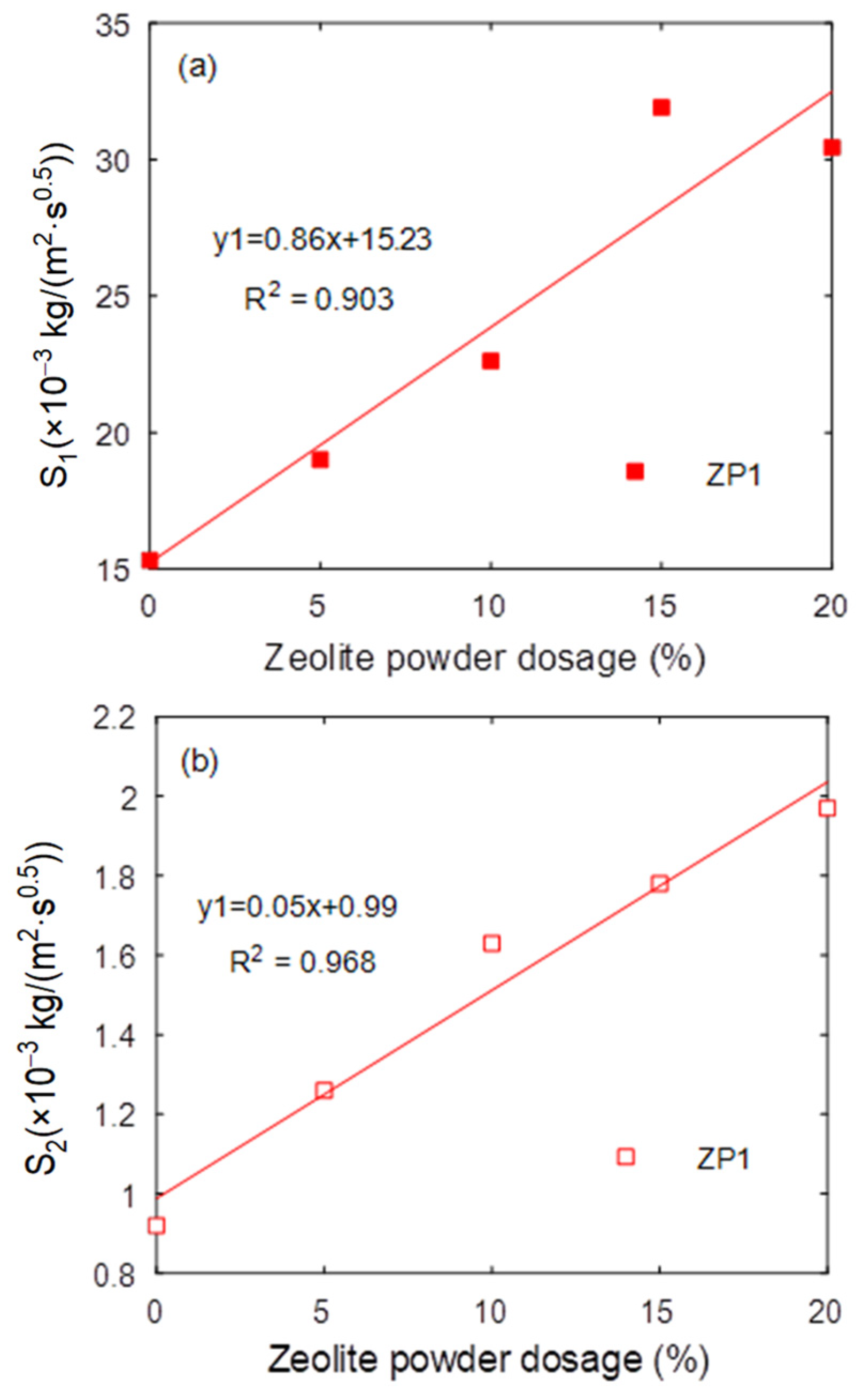
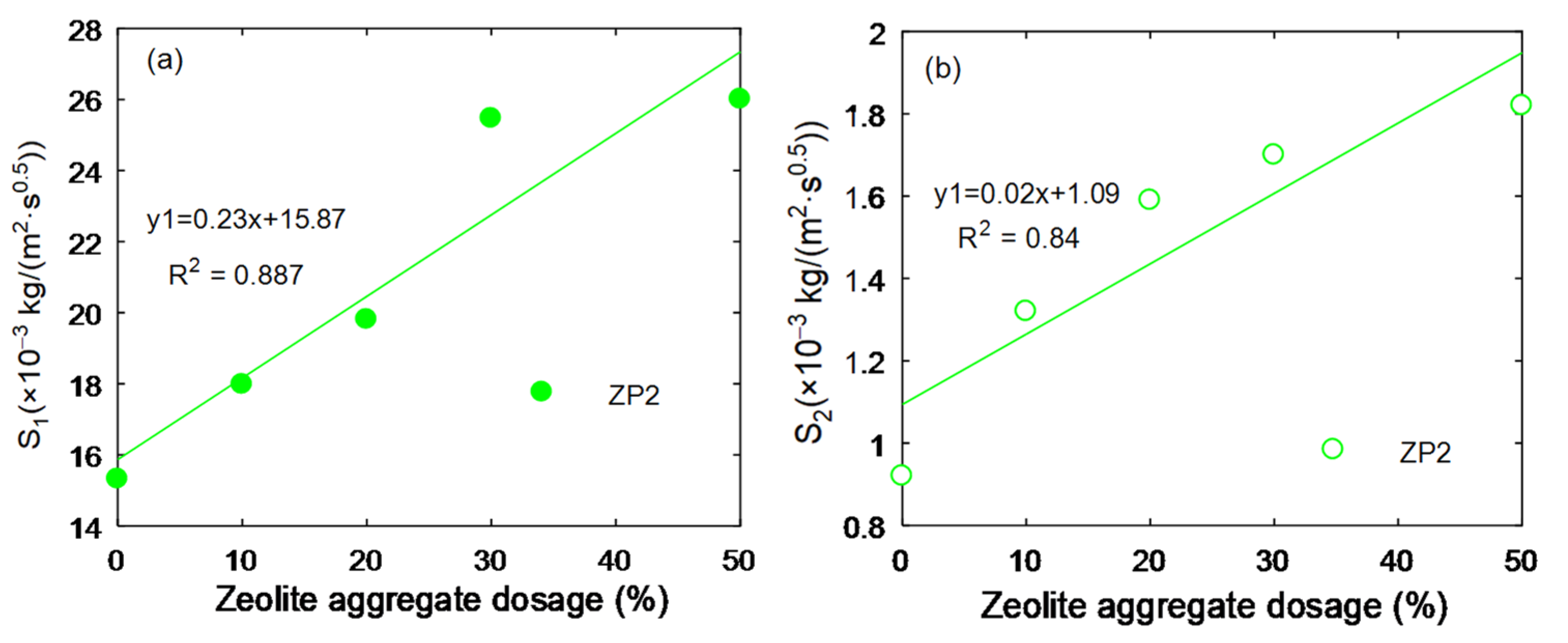
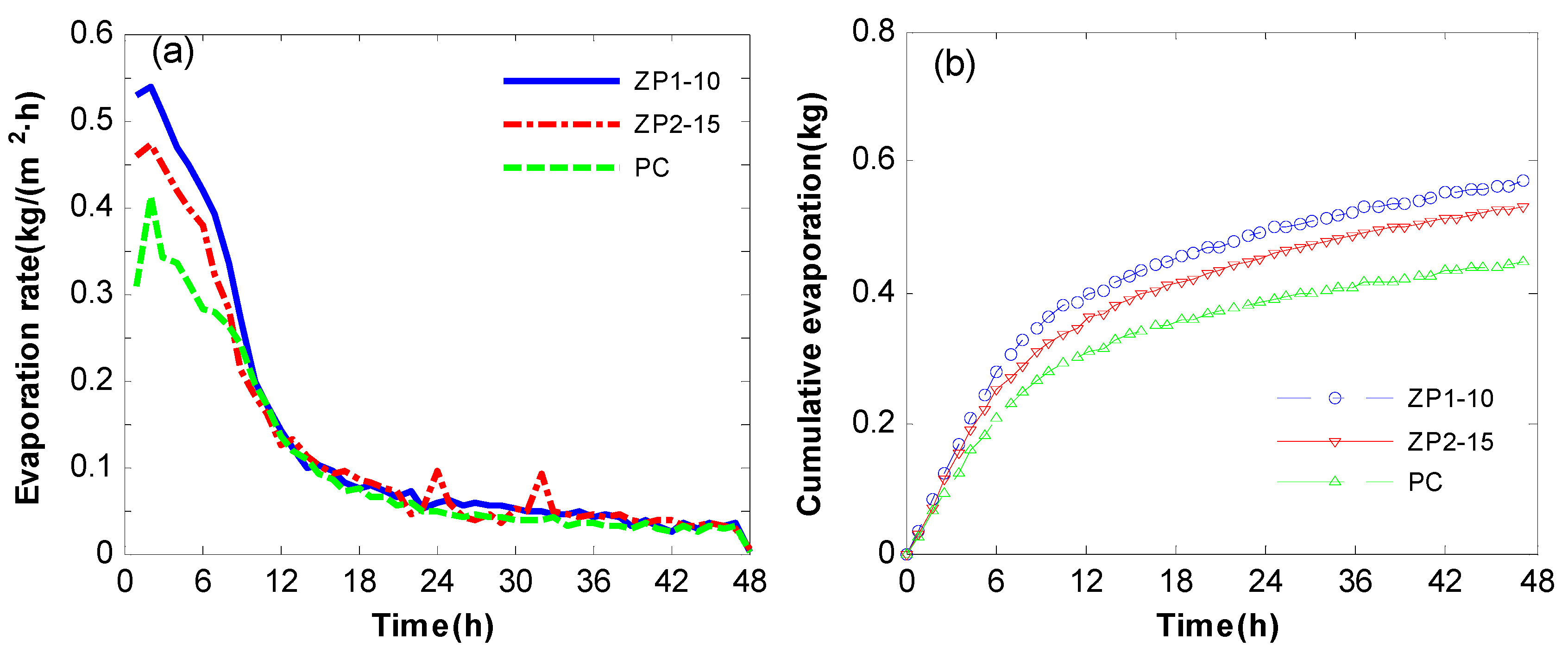
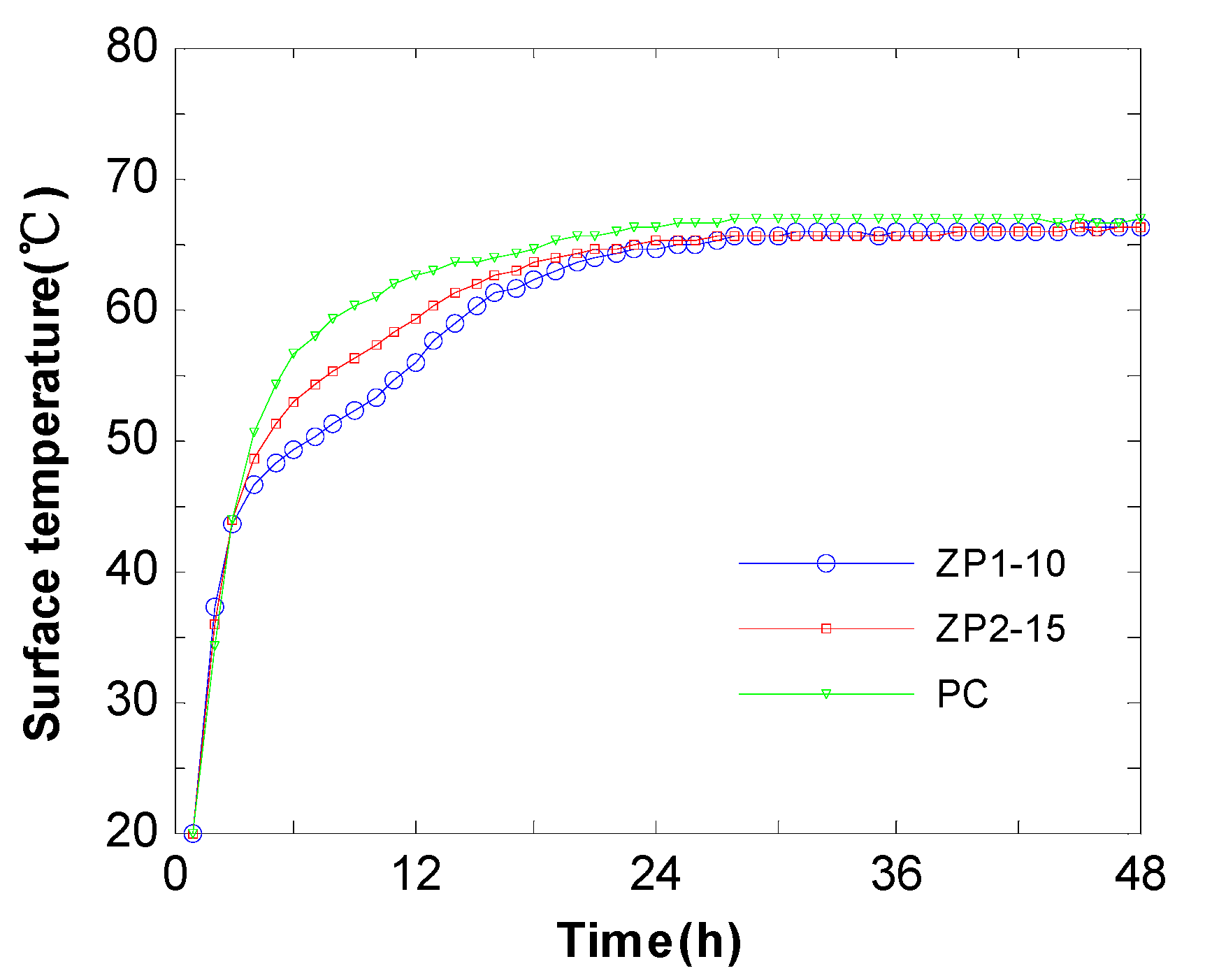
| Specify Gravity (g/cm3) | Blaine Specific Surface (m2/kg) | Setting Time (min) | Compressive Strength (MPa) | ||
|---|---|---|---|---|---|
| Initial Setting | Final Setting | 3 d | 28 d | ||
| 3.09 | 364 | 124 | 203 | 38.5 | 50.2 |
| Chemical Composition (%) | CaO | SiO2 | Al2O3 | Fe2O3 | MgO | K2O | Na2O | SO3 |
|---|---|---|---|---|---|---|---|---|
| Cement | 63.92 | 21.08 | 4.54 | 3.65 | 1.76 | 0.73 | 0.58 | 2.05 |
| Zeolite | 1.98 | 66.28 | 12.72 | 0.68 | 0.45 | 2.98 | 2.25 | 0.34 |
| Mix ID | Cement | Aggregates | Water | Coarse Zeolite | Fine Zeolite | Sand | Water Reducer |
|---|---|---|---|---|---|---|---|
| CK | 302.0 | 1509.0 | 105.7 | 0 | 0 | 167.7 | 1.4 |
| ZP1-5 | 286.9 | 1509.0 | 105.7 | - | 15.1 | 167.7 | 1.4 |
| ZP1-10 | 271.8 | 1509.0 | 105.7 | - | 30.2 | 167.7 | 1.4 |
| ZP1-15 | 256.7 | 1509.0 | 105.7 | - | 45.3 | 167.7 | 1.4 |
| ZP1-20 | 241.6 | 1509.0 | 105.7 | - | 60.4 | 167.7 | 1.4 |
| ZP2-10 | 302.0 | 1358.1 | 105.7 | 150.9 | - | 167.7 | 1.4 |
| ZP2-20 | 302.0 | 1207.2 | 105.7 | 301.8 | - | 167.7 | 1.4 |
| ZP2-30 | 302.0 | 1056.3 | 105.7 | 452.7 | - | 167.7 | 1.4 |
| ZP2-50 | 302.0 | 754.5 | 105.7 | 754.5 | - | 167.7 | 1.4 |
| Property | Standard Followed | Remarks |
|---|---|---|
| Hardened density | ASTMC1699 [25] | |
| Porosity | ||
| Permeability | ASTM C1701 [26] | The water permeability of the samples was tested using a constant head method. Here, the water head difference across the sample was 6 cm. |
| Water absorption and sorptivity | ASTM C1585 [27] | To measure the water absorption, we cut the specimen into a shape with 100 × 100 × 60 mm3, sealed the four sides and top of it with the waterproof tape, and then placed the specimen above a water bath with the bottom of it approximately 3–5 mm contact with the water. |
| Compressive strength | ASTM C39 [28] | |
| Splitting tensile strength | ASTM C496 [29] |
Disclaimer/Publisher’s Note: The statements, opinions and data contained in all publications are solely those of the individual author(s) and contributor(s) and not of MDPI and/or the editor(s). MDPI and/or the editor(s) disclaim responsibility for any injury to people or property resulting from any ideas, methods, instructions or products referred to in the content. |
© 2023 by the authors. Licensee MDPI, Basel, Switzerland. This article is an open access article distributed under the terms and conditions of the Creative Commons Attribution (CC BY) license (https://creativecommons.org/licenses/by/4.0/).
Share and Cite
Guo, K.; Guo, S.; Chen, X.; Qi, Q. Mechanical and Hygrothermal Properties of Zeolite-Modified Pervious Concrete in Hot and Humid Area. Sustainability 2023, 15, 2092. https://doi.org/10.3390/su15032092
Guo K, Guo S, Chen X, Qi Q. Mechanical and Hygrothermal Properties of Zeolite-Modified Pervious Concrete in Hot and Humid Area. Sustainability. 2023; 15(3):2092. https://doi.org/10.3390/su15032092
Chicago/Turabian StyleGuo, Kaiwen, Shiping Guo, Xingji Chen, and Qianlong Qi. 2023. "Mechanical and Hygrothermal Properties of Zeolite-Modified Pervious Concrete in Hot and Humid Area" Sustainability 15, no. 3: 2092. https://doi.org/10.3390/su15032092




